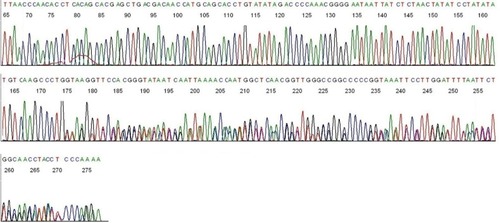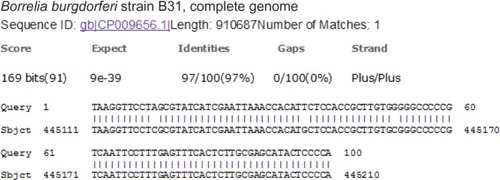Figures & data
Figure 1 Base-calling electropherogram of borrelial 16S rRNA gene sequencing, using M2 as the sequencing primer.
Notes: Computer-generated electropherogram is presented. BLAST alignment algorithm showed that the first unambiguous 110 bases, TTAACCCAACACCTCACAGCACGAGCTGACGACAACCATGCAGCACCTGTATATAGACCCCAAACGGGGAATAATTATCTCTAACTATATCCTATATATGTCAAGCCCTG, represent a signature sequence of the Borrelia burgdorferi sensu lato 16S rRNA gene (GenBank sequence ID CP009656, range: 445,000–445,109). Visual analysis showed that the immediately downstream 100-base segment with numerous double peaks is a composite of two superimposed sequences shown later: A:GTAAGGTTCCTCGCGTATCATCGAATTAAACCACATGCTCCACCGCTTGTGCGGGCCCCCGTCAATTCCTTTGAGTTTCACTCTTGCGAGCATACTCCCC; and B:TAAGGTTCCTAGCGTATCATCGAATTAAACCACATTCTCCACCGCTTGTGGGGGCCCCCGTCAATTCCTTTGAGTTTCACTCTTGCGAGCATACTCCCCA.
Abbreviations: BLAST, Basic Local Alignment Search Tool; rRNA, ribosomal RNA.
Abbreviations: BLAST, Basic Local Alignment Search Tool; rRNA, ribosomal RNA.


